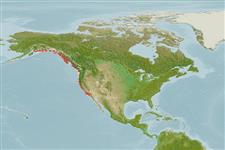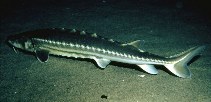Acipenser medirostris Ayres, 1854
Green sturgeon
Waarneming toevoegen in Fish Watcher
| Native range | All suitable habitat | Point map | Year 2050 |

|
| This map was computer-generated and has not yet been reviewed. |
| Acipenser medirostris AquaMaps Data sources: GBIF OBIS |
Uploaden van uw Foto's en video's
Pictures | Google afbeeldingAcipenser medirostris
Picture by Gotshall, D.W.
Pictures | Google afbeeldingAcipenser medirostris
Picture by Gotshall, D.W.
United States (contiguous states) country information
Common names:
Green sturgeon, Green sturgeon, Stutch'-un
Occurrence: native
Salinity: freshwater
Abundance: | Ref:
Importance: of no interest | Ref:
Aquaculture: | Ref:
Regulations: | Ref:
Uses: gamefish: yes;
Comments: Not common in Puget Sound, Washington in 1895 (Ref. 28609). Rarely found in freshwater. Sport fishery for fish exceeding 100 cm in Delta Area of San Francisco Bay (Ref. 4563). Also Ref. 4925, 6885, 28553. Status of threat: vulnerable. Criteria: 1,2 (http://fisc.er.usgs.gov/afs/) (Ref. 81264).
National Checklist:
Country Information: https://www.cia.gov/library/publications/resources/the-world-factbook/geos/us.html
National Fisheries Authority: http://www.nmfs.gov
Occurrences: Occurrences Point map
Main Ref: Eschmeyer, W.N., E.S. Herald and H. Hammann, 1983
National Database:
Occurrence: native
Salinity: freshwater
Abundance: | Ref:
Importance: of no interest | Ref:
Aquaculture: | Ref:
Regulations: | Ref:
Uses: gamefish: yes;
Comments: Not common in Puget Sound, Washington in 1895 (Ref. 28609). Rarely found in freshwater. Sport fishery for fish exceeding 100 cm in Delta Area of San Francisco Bay (Ref. 4563). Also Ref. 4925, 6885, 28553. Status of threat: vulnerable. Criteria: 1,2 (http://fisc.er.usgs.gov/afs/) (Ref. 81264).
National Checklist:
Country Information: https://www.cia.gov/library/publications/resources/the-world-factbook/geos/us.html
National Fisheries Authority: http://www.nmfs.gov
Occurrences: Occurrences Point map
Main Ref: Eschmeyer, W.N., E.S. Herald and H. Hammann, 1983
National Database:
Common names from other countries
Classificatie / Names Lokale namen | Synoniemen | Catalog of Fishes(Genus, Soort(en)) | ITIS | CoL | WoRMS | Cloffa
> Acipenseriformes (Sturgeons and paddlefishes) > Acipenseridae (Sturgeons) > Acipenserinae
Etymology: Acipenser: Latin, acipenser = sturgeon, 1853 (Ref. 45335); medirostris: The specific name is derived from medirostris, referring to its moderate snout (Ref. 1998).
More on author: Ayres.
Etymology: Acipenser: Latin, acipenser = sturgeon, 1853 (Ref. 45335); medirostris: The specific name is derived from medirostris, referring to its moderate snout (Ref. 1998).
More on author: Ayres.
Environment: milieu / climate zone / depth range / distribution range Ecologie
marien; zoet water; brak water demersaal; anadroom (Ref. 120652); diepte 0 - 80 m (Ref. 50610). Temperate; 10°C - 20°C (Ref. 2059); 65°N - 32°N, 166°W - 114°W (Ref. 54261)
Verspreiding Landen | FAO regio's | Ecosystemen | Voorkomen | Point map | Introducties | Faunafri
North America: Aleutian Islands and the Gulf of Alaska to Ensenada, Mexico. Considered vulnerable in Canada. The Asian population is now considered to be a separate species Acipenser mikadoi (Ref. 6866).
Lengte bij maturiteit / Grootte / Gewicht / Leeftijd
Maturity: Lm ?, range 162 - ? cm
Max length : 270 cm TL mannelijk / geslacht onbekend; (Ref. 96339); common length : 130 cm TL mannelijk / geslacht onbekend; (Ref. 12193); max. gepubliceerd gewicht: 159.0 kg (Ref. 2850); max. gerapporteerde leeftijd: 60 Jaren (Ref. 72476)
Max length : 270 cm TL mannelijk / geslacht onbekend; (Ref. 96339); common length : 130 cm TL mannelijk / geslacht onbekend; (Ref. 12193); max. gepubliceerd gewicht: 159.0 kg (Ref. 2850); max. gerapporteerde leeftijd: 60 Jaren (Ref. 72476)
Korte beschrijving Determinatiesleutels | Morfologie | Morfometrie
Dorsale stekels (totaal) : 0; Dorsale zachte stralen (totaal) : 33 - 35; Anale stekels: 0; Anale zachte stralen: 22 - 28. Characterized by a single row of 1 to 4 bony plates along the midventral line between the anus and the anal fin, and about 33 to 35 rays in the dorsal fin. Dorsal arises at posterior third of the total length; anal fin arises under posterior part of dorsal; pectorals originate low on the body just behind gill opening and are large and rounded; pelvic fins arise near the anus. Generally olive to dark green, lower parts more or less whitish green; a longitudinal olive-green stripe on side between lateral and ventrolateral plates, another on midventral surface; fins grayish to pale green (Ref. 27547). Barbels usually situated closer to mouth than to snout tip; coloration of scutes along side paler than skin (Ref. 86798).
Found in estuaries, lower reaches of large rivers, and in salt or brackish water off river mouths (Ref. 5723). Probably spawns in fresh water (Ref. 27547). May cover considerable distances in the ocean (Ref. 27547). Edible but with a disagreeable taste and unpleasant odor (Ref. 1998).
Levenscyclus en paargedrag Maturiteit | Voortplanting | Paaien | Eieren | Fecunditeit | Larven
Hoofdreferentie
Upload your references | Referenties | Coördinator | Medewerkers
Page, L.M. and B.M. Burr, 1991. A field guide to freshwater fishes of North America north of Mexico. Houghton Mifflin Company, Boston. 432 p. (Ref. 5723)
Status op de Rode Lijst van het IUCN (Ref. 130435: Version 2024-2)
Bedreigd (EN) (A2bc); Date assessed: 14 September 2019
Gevaar voor de mens
Harmless
Gebruik door de mens
Visserij: van minder commercieel belang; sportvis: ja
FAO(visserij: productie, soortsprofiel; publication : search) | FishSource | Sea Around Us
Meer informatie
Population dynamics
Groeiparameters
Max. ages / sizes
Length-weight rel.
Length-length rel.
Lengtefrequenties
Massaconversie
Rekrutering
Abundantie
Groeiparameters
Max. ages / sizes
Length-weight rel.
Length-length rel.
Lengtefrequenties
Massaconversie
Rekrutering
Abundantie
Life cycle
Voortplanting
Maturiteit
Fecunditeit
Paaien
Spawning aggregations
Eieren
Ontwikkeling van de eieren
Larven
Larvale populatiedynamiek
Voortplanting
Maturiteit
Fecunditeit
Paaien
Spawning aggregations
Eieren
Ontwikkeling van de eieren
Larven
Larvale populatiedynamiek
Anatomy
Kieuwoppervlak
Brain
Otolith
Kieuwoppervlak
Brain
Otolith
Physiology
Body composition
Nutrients
Zuurstofverbruik
Zwemtype
Zwemsnelheid
Visual pigments
Fish sound
Diseases & Parasites
Toxicity (LC50s)
Body composition
Nutrients
Zuurstofverbruik
Zwemtype
Zwemsnelheid
Visual pigments
Fish sound
Diseases & Parasites
Toxicity (LC50s)
Human related
Aquaculture systems
Aquacultuurprofielen
Kweeklijnen
Ciguatera cases
Stamps, coins, misc.
Aquaculture systems
Aquacultuurprofielen
Kweeklijnen
Ciguatera cases
Stamps, coins, misc.
Tools
Bio-Quiz | E-boek | Veldgids | Lengtefrequentie Tool | Levenscyclus tool | Verspreidingskaart | Classification Tree
| Catch-MSY |
Speciale rapporten
Bekijk gegevens voor het houden in een aquarium | Bekijk Fact Sheets voor de soort | Bekijk Aquacultuur Fact Sheets
Download XML
Internetbronnen
Aquatic Commons | BHL | Cloffa | BOLDSystems | Websites from users | Bekijk FishWatcher | CISTI | Catalog of Fishes(Genus, Soort(en)) | DiscoverLife | ECOTOX | Faunafri | Fishtrace | GenBank(genoom, nucleotide) | GloBI | GOBASE | | Google Books | Google Scholar | Google | IGFA World Record | MitoFish | Otolith Atlas of Taiwan Fishes | PubMed | Reef Life Survey | Scirus | SeaLifeBase | Tree of Life | Wikipedia(ga naar, zoek) | World Records Freshwater Fishing | Zoobank | Zoological Record
Estimates based on models
Preferred temperature (Ref. 115969): 9.1 - 12.7, mean 10.6 (based on 50 cells).
Fylogenetische diversiteitsindex (Ref. 82804): PD50 = 0.5000 [Uniqueness, from 0.5 = low to 2.0 = high].
Bayesian length-weight: a=0.00389 (0.00180 - 0.00842), b=3.12 (2.94 - 3.30), in cm Total Length, based on all LWR estimates for this body shape (Ref. 93245).
Trofisch niveau (Ref. 69278): 3.5 ±0.52 se; based on food items.
Weerstandsvermogen (Ref. 120179): laag, minimale populatieverdubbelingstijd 4,5-14 jaar (K=0.05-0.09).
Fishing Vulnerability (Ref. 59153): Very high vulnerability (80 of 100).
Climate Vulnerability (Ref. 125649): High to very high vulnerability (67 of 100).




